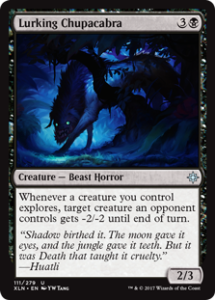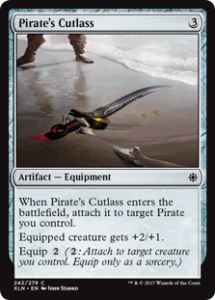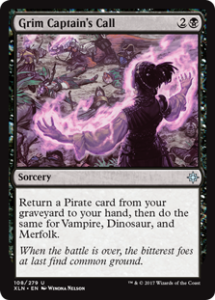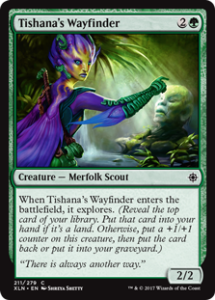I had the pleasure of participating in two Ixalan prerelease events this past weekend. The format seems sweet and full of lenticular complexity. There are a ton of decisions to be made when drafting, deckbuilding, and sequencing plays; but many are hidden in card interactions and seemingly simple set mechanics. This should make the format both approachable to less experienced players while also deeply satisfying for entrenched spellslingers. I’m extremely excited to draft it all week long on Magic Online. But first, there are stories to be told!

Captains without a Crew
Both of my prerelease decks featured a stamped Fathom Fleet Captain, a Ruin Raider, and a Grim Captain’s Call. Both were severely lacking in the pirate department, making them unable to make good use of Fathom Fleet Captain, who had to settle for being a great attacker who rarely became a win condition.
Both decks struggled to play into the recommended themes, which makes sense, since there aren’t a ton of tribal rewards (mostly a lot of little interactions). The first was a WB Vampire-Pirate-Dinosaur deck (the ol’ 5-5-4 split) and the latter was a BG goodstuff deck with several explore creatures and a Lurking Chupacabra (who turned out to be slow, but amazing when the game stalled out). Neither deck was particularly good, but each introduced me to a card which deeply impressed me.

The Ol’ Trusty Cutlass
Pirate’s Cutlass was the winning factor for most games with my WB deck, usually on a flying or lifelink creature. This unassuming card dramatically overperformed, reminding me of one of the best uncommons in Zendikar: Trusty Machete. The machete is a powerful and inexpensive piece of equipment in a blisteringly fast format where players had mana to spare (because decks overloaded on lands to keep hitting Landfall triggers). Pirate’s Cutlass costing three is a big downgrade to Trusty Machete. It’s fighting with creatures at that spot in the curve, whereas Trusty Machete had basically no competition on turn one.
However, if you’ve got a pirate, you’re paying the exact same mana cost for Pirate’s Cutlass as you did Trusty Machete. Once the cutlass is in play, it’s exactly the same as Trusty Machete. Unholy Strength is a sizable boon on an equipment, and two mana is a reasonable cost to equip. Moreover, there are plenty of creatures with abilities like flying and lifelink to magnify the value of two extra power.
Now, I don’t expect Pirate’s Cutlass to be a top pick by any stretch of the imagination. However, it looks to be a solid reward for being in pirates and a card one may be happy to open in Sealed, given how difficult it may be to benefit from Ixalan’s limited Limited tribal synergies.

Raise the Tidings Yo Ho
Grim Captain’s Call looks to be a really bad Raise Dead. The set pushes players to go tribal, and Grim Captain’s Call works worse when you succeed. It can’t even rebuy a large number of creatures in the set, like humans, dryads, and the lonely trilobite. Historically, we’ve seen Death’s Duet style cards become stronger (such as Wander in Death) but rendered weak by how much better aggressive creatures have gotten. Grim Captain’s Call should be awful, but it was one of the best cards in both of my decks.
In Sealed, games can drag on, becoming battles of attrition defined by card advantage. Much of this is due to players having access to high power level cards, but low deck synergy. This is fertile ground for a card designed to rebuy a mish-mash of powerful creatures from across archetypes. And no matter what color pair you’re in, it’s guaranteed to be able to rebuy at least three of the four major tribes. Black gives you access to pirates and vampires, white and red add dinosaurs, blue adds merfolk, and green adds both dinosaurs and merfolk (allowing me to cast it for wondrous complete value with my BG deck). Grim Captain’s Call probably isn’t a high pick in draft and won’t fit into every deck, but it can be a more powerful and cheaper Concentrate or Tidings in the right situation.

Ixalan has many of the hallmarks of a great format: support for greedy multicolor decks in treasure tokens, support for aggressive decks (have you seen how many good two drops are at common?), mana-smoothing in Explore, a bunch of mana sinks (even though there isn’t a mana sink mechanic), and strong archetypes that aren’t so overpowered as to put players on rails. I look forward to seeing how the format shapes up, particularly how unassuming commons and uncommons like Pirate’s Cutlass and Grim Captain’s Call can maneuver their way into being powerhouses. Here’s hoping the format is an absolute (cannon) blast.
And, as always, thanks for reaching.
—Zachary Barash
Zachary Barash is a New York City-based game designer. He works for Kingdom Death: Monster, has an MFA in Game Design from NYU, and does freelance game design.
His favorite card of the month is Censor. Every component of Censor is weak (neither U: Draw a card, nor two mana Force Spike for two mana is good), but put together it’s not only a formidable and flexible spell, it creates a powerful moment when you get someone with it. A Counterspell always hits its mark, but a Censor demands that you time it just right, that your opponent doesn’t see it coming or can’t help but play into it. And because actually countering a spell with it requires so much precision, the cycling cost is basically negligible, making it good (but rarely great) at every stage of the game. Compare it with the also-cool, bigger version in Countervailing Winds, which is also its own nifty design and another callback to powerful countermagic of old.

